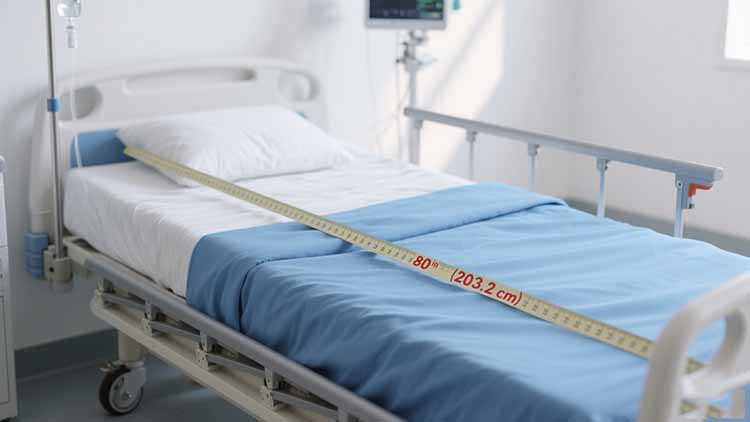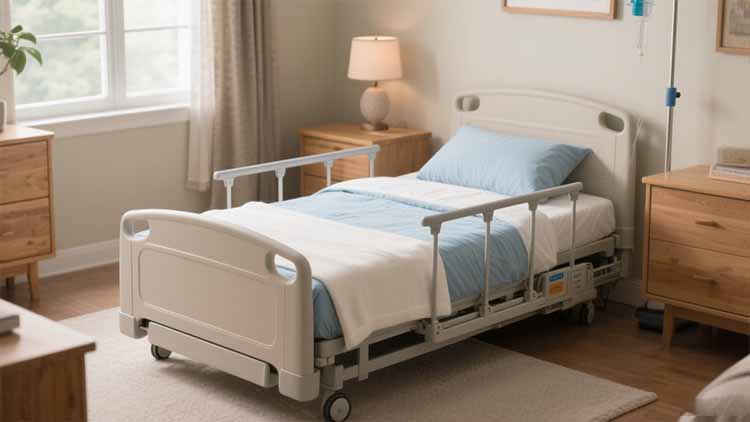Source: Author: Time:2025-09-23 11:00:07 Views:498
When outfitting a medical facility, home care space, or even researching for a loved one’s needs, understanding hospital bed dimensions is critical. The right hospital bed size ensures patient comfort, safety, and compatibility with medical equipment—while the wrong size can lead to discomfort, increased fall risks, or wasted resources. In this guide, we’ll break down standard and specialty hospital bed dimensions, explain how to choose the right hospital bed mattress and hospital bed sheet, and answer common questions about hospital bed sizing.
Hospital beds aren’t one-size-fits-all. Unlike residential beds, they’re designed to support patients with varying medical needs—from basic recovery to long-term care. Proper hospital bed size impacts:
Most acute care facilities and home care settings use standard hospital beds, which follow industry-wide size guidelines. Here’s a breakdown of key measurements:
The average hospital bed width for adult patients is 36 inches (91.4 cm). This width balances patient comfort (enough space to shift positions) with caregiver accessibility (easy to reach from either side). For bariatric patients (those with higher weight needs), bariatric hospital beds are wider—typically 42 to 48 inches (106.7 to 121.9 cm). Pediatric hospital beds are smaller, ranging from 24 to 30 inches (61 to 76.2 cm) wide, depending on the child’s age.
Standard adult hospital bed length is 80 inches (203.2 cm). However, many “extended length” hospital beds are available (up to 84 inches/213.4 cm) to fit taller patients. Pediatric hospital bed lengths vary by age: newborn beds (incubators) may be as short as 30 inches (76.2 cm), while adolescent beds can match adult lengths.

Hospital bed height is adjustable to support patient transfers and caregiver ergonomics. Most beds adjust from 15 inches (38.1 cm) (lowest setting, ideal for safe transfers) to 30 inches (76.2 cm) (highest setting, easier for caregivers to change linens or assist with medical tasks). Some specialty beds offer even wider height ranges for bariatric or mobility-impaired patients.
Beyond standard beds, specialty hospital beds are designed for specific patient needs. Understanding their dimensions ensures you select the right option:
As mentioned, bariatric beds are wider (42–48 inches) to support patients with weights up to 1,000 lbs (453.6 kg). They also have reinforced frames and wider mattresses to prevent sagging. Some bariatric beds have extended lengths (84 inches) to accommodate taller patients.
Low hospital beds (also called “low-height beds”) are designed for fall prevention. Their minimum height is as low as 10 inches (25.4 cm), making it easier for patients to get in and out without assistance. Width and length match standard adult beds (36x80 inches) in most cases.
Home hospital beds are often compact to fit residential spaces. While many match standard adult dimensions (36x80 inches), some “narrow home hospital beds” are 30–33 inches wide—ideal for small bedrooms. They still offer adjustability (height, head/foot elevation) but with a more streamlined design than hospital-grade beds.

A hospital bed mattress isn’t just a comfort accessory—it’s a medical tool. Its size must match the hospital bed dimensions exactly to prevent gaps (which can trap limbs or cause falls) and ensure proper support. Here’s what to consider:
Always select a mattress that matches the bed frame’s inner dimensions. For a standard 36x80 inch hospital bed, choose a 36x80 inch hospital bed mattress. Bariatric beds require wider mattresses (42–48 inches), while pediatric beds need smaller, age-appropriate sizes.
- Foam mattresses: Ideal for patients at low risk of pressure sores. They’re lightweight and offer basic support.
- Air mattresses: Use alternating air cells to reduce pressure on the body, preventing pressure ulcers. They’re common for long-term care patients.
- Hybrid mattresses: Combine foam and air support for maximum comfort and pressure relief.
- Bariatric mattresses: Reinforced foam or air mattresses designed to support higher weights without sagging.
Most hospital bed mattresses are 6–8 inches (15.2–20.3 cm) thick. Thicker mattresses (10–12 inches) may offer more comfort but can reduce under-bed clearance—important if you use a bed lift or mobility device.
Hospital bed sheets must fit snugly to avoid slipping (a fall hazard) and be durable enough to withstand frequent washing (standard in healthcare settings). Here’s how to choose the right sheets:
Like mattresses, hospital bed sheets must align with hospital bed dimensions. For a standard 36x80 inch mattress, look for “standard hospital bed sheets” (36x80 inches). Bariatric sheets are wider (42–48 inches), and pediatric sheets come in smaller sizes (24–30 inches wide). “Fitted sheets” are preferred over flat sheets because they stay in place better—look for deep pockets (6–8 inches) to fit thick hospital bed mattresses.
- Cotton/polyester blends: The most common choice—durable, wrinkle-resistant, and easy to launder.
- 100% cotton: More breathable for patients who sleep hot, but less durable than blends.
- Antimicrobial sheets: Treated to resist bacteria, ideal for patients with compromised immune systems.
Look for hospital bed sheets with elasticized corners (for a snug fit) and reinforced seams (to prevent tearing). Some sheets are designed to work with adjustable beds (head/foot elevation) without slipping.
No. Regular mattresses aren’t designed to fit hospital bed dimensions (they may be too wide/narrow) and won’t support adjustable bed frames. They also lack the pressure-relief features needed for medical patients.
Measure the width (from side to side) and length (from head to foot) of the mattress. Add 2–3 inches to the width/length if you prefer loose-fitting sheets, but most hospital bed sheets are pre-sized for standard mattresses.
No. Hospital bed height is adjustable, but most have a range of 15–30 inches. Low beds have a lower minimum height (10 inches), while bariatric beds may have a higher maximum height.
Home care beds are often smaller (30–33 inches wide) to fit residential spaces, but they still follow standard hospital bed dimensions for length (80 inches). They may have fewer features than hospital-grade beds but offer basic adjustability.
Understanding hospital bed dimensions is key to creating a safe, comfortable environment for patients—whether in a medical facility or at home. By matching the bed size to the patient’s needs, choosing the right hospital bed mattress and hospital bed sheet, and considering specialty options (like bariatric or low beds), you can ensure optimal care and recovery. Always refer to the manufacturer’s guidelines for specific bed dimensions, and don’t hesitate to consult a medical professional if you’re unsure which size is best.


